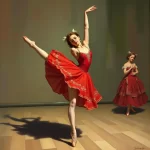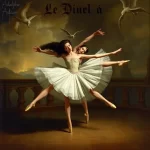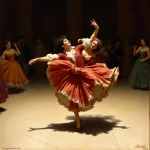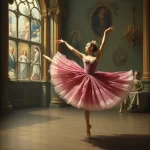Ballet: Petrushka (Igor Stravinsky, 1911)

Introduction
Ballet, a classical dance form known for its grace and precision, has produced numerous masterpieces over the centuries. One such iconic work is “Petrushka,” a ballet composed by Igor Stravinsky in 1911. This ballet, choreographed by Michel Fokine, premiered on June 13, 1911, at the Théâtre du Châtelet in Paris. “Petrushka” tells the story of a tragic love triangle involving three puppets: Petrushka, the Ballerina, and the Moor, set against the backdrop of a bustling Russian fair. The ballet is celebrated for its innovative music, choreography, and its profound emotional depth.
Historical Background
Creation and Development
“Petrushka” was created during a period of significant artistic innovation in the early 20th century. The ballet emerged from the collaboration between composer Igor Stravinsky and choreographer Michel Fokine, both of whom were associated with Sergei Diaghilev’s Ballets Russes. The Ballets Russes was a groundbreaking ballet company that revolutionized the art form by integrating modernist elements and collaborating with contemporary artists, composers, and designers.
The inspiration for “Petrushka” came from Russian folklore and the traditional puppet theater. Stravinsky and Fokine sought to create a ballet that combined the whimsical and the tragic, reflecting the complexities of human emotions. The character of Petrushka, a puppet with human-like feelings, became the central figure of this narrative.
Premiere and Reception
“Petrushka” premiered on June 13, 1911, at the Théâtre du Châtelet in Paris. The initial reception was mixed, with some critics praising the innovative music and choreography, while others found it challenging to grasp the avant-garde elements. However, the ballet quickly gained recognition for its originality and emotional depth. Notable early performances included revivals by the Ballets Russes and other prominent ballet companies, solidifying “Petrushka” as a staple in the ballet repertoire.
Synopsis of the Ballet
“Petrushka” is a one-act ballet divided into four scenes, each depicting different aspects of the story.
Scene 1: The Shrovetide Fair
The ballet opens with a lively scene at a Russian fair during the Shrovetide festival. The bustling crowd enjoys various attractions, including street performers and vendors. Amidst the festivities, a Charlatan introduces three puppets: Petrushka, the Ballerina, and the Moor. The Charlatan brings the puppets to life with his magic flute, and they begin to dance, captivating the audience.
Scene 2: Petrushka’s Room
The scene shifts to Petrushka’s small, confined room. Here, Petrushka reveals his deep emotions and longing for freedom. He is in love with the Ballerina but is tormented by his puppet-like existence. The music reflects Petrushka’s inner turmoil, with dissonant and fragmented melodies.
Scene 3: The Moor’s Room
In contrast to Petrushka’s room, the Moor’s room is lavish and opulent. The Moor is a carefree and arrogant character who also desires the Ballerina. The Ballerina enters, and the Moor attempts to woo her with his exotic charm. The scene is marked by playful and seductive music, highlighting the Moor’s flamboyant personality.
Scene 4: The Fair Again
The final scene returns to the fair, where the puppets’ drama reaches its climax. Petrushka, driven by jealousy and despair, confronts the Moor. A violent struggle ensues, and the Moor fatally wounds Petrushka. The crowd is shocked, but the Charlatan reassures them that it is just a puppet show. As the fair continues, Petrushka’s ghost appears, haunting the Charlatan and leaving the audience with a sense of melancholy and reflection.
Musical Composition
Composer’s Role
Igor Stravinsky, one of the most influential composers of the 20th century, played a pivotal role in the creation of “Petrushka.” His innovative score blends traditional Russian folk music with modernist elements, creating a unique and dynamic soundscape. Stravinsky’s use of dissonance, polytonality, and rhythmic complexity was groundbreaking and contributed significantly to the ballet’s emotional impact.
Musical Themes and Motifs
The music of “Petrushka” is characterized by recurring themes and motifs that represent the characters and their emotions. The “Petrushka chord,” a dissonant combination of C major and F-sharp major triads, is a prominent motif that symbolizes Petrushka’s anguish and inner conflict. The score also features lively folk tunes and dance rhythms that evoke the festive atmosphere of the fair. Stravinsky’s music enhances the narrative by reflecting the characters’ personalities and the dramatic developments in the story.
Famous Recordings and Performances
Several iconic recordings of “Petrushka” have been made over the years, showcasing the brilliance of Stravinsky’s composition. Notable recordings include those conducted by Stravinsky himself, as well as performances by renowned orchestras such as the New York Philharmonic and the London Symphony Orchestra. These recordings capture the energy and emotional depth of the ballet’s music, making them essential listening for classical music enthusiasts.
Choreography and Dance
Choreographer’s Vision
Michel Fokine, a pioneering choreographer of the early 20th century, brought his unique vision to “Petrushka.” Fokine’s choreography emphasized expressive movement and dramatic storytelling, breaking away from the rigid conventions of classical ballet. He sought to create a seamless integration of dance, music, and narrative, allowing the characters’ emotions to be conveyed through their movements.
Signature Dance Numbers
“Petrushka” features several key dance numbers that are integral to the story. The opening dance at the fair sets the stage with its lively and energetic choreography. Petrushka’s solo in his room is a poignant and expressive piece that captures his inner turmoil. The Moor’s dance with the Ballerina is characterized by its playful and seductive movements. The final confrontation between Petrushka and the Moor is a dramatic and intense sequence that culminates in Petrushka’s tragic demise.
Notable Interpretations
Over the years, different productions of “Petrushka” have offered unique interpretations of the choreography. Some have emphasized the ballet’s folkloric elements, while others have focused on its psychological depth. Notable dancers such as Vaslav Nijinsky, Rudolf Nureyev, and Mikhail Baryshnikov have portrayed Petrushka, each bringing their own interpretation to the character. These diverse interpretations have contributed to the ballet’s enduring appeal and relevance.
Characters and Roles
Main Characters
- Petrushka: The central character, a puppet with human-like emotions. Petrushka is in love with the Ballerina but is tormented by his puppet existence.
- The Ballerina: A beautiful and graceful puppet who is desired by both Petrushka and the Moor. She represents unattainable love for Petrushka.
- The Moor: A flamboyant and arrogant puppet who also desires the Ballerina. He is Petrushka’s rival and ultimately kills him in a fit of jealousy.
Supporting Characters
- The Charlatan: A magician who brings the puppets to life and orchestrates the events at the fair. He represents the manipulative forces controlling the characters’ fates.
- The Fairgoers: Various characters who populate the fair, adding to the lively and festive atmosphere. They serve as both spectators and participants in the unfolding drama.
Famous Dancers
Several renowned dancers have portrayed the roles in “Petrushka” over the years. Vaslav Nijinsky, one of the greatest male dancers of the early 20th century, was the original Petrushka and brought a profound emotional depth to the character. Rudolf Nureyev and Mikhail Baryshnikov, both legendary dancers, have also given memorable performances as Petrushka, each adding their own unique interpretation to the role.
Cultural and Artistic Impact
Influence on Ballet and Dance
“Petrushka” has had a significant influence on the world of ballet and dance. Its innovative choreography and music have inspired countless choreographers and composers. The ballet’s emphasis on expressive movement and dramatic storytelling paved the way for future developments in modern dance. “Petrushka” also contributed to the evolution of character-driven narratives in ballet, where the focus is on the emotional and psychological depth of the characters.
Cultural Significance
Beyond the realm of ballet, “Petrushka” has left its mark on popular culture and other art forms. The character of Petrushka has appeared in various adaptations, including films, theater productions, and literature. The ballet’s themes of love, jealousy, and existential angst resonate with audiences across different mediums, making it a timeless and universal story.
Legacy and Revivals
“Petrushka” continues to be performed and celebrated today, with major revivals and reinterpretations by leading ballet companies around the world. Modern adaptations often incorporate contemporary elements while staying true to the original spirit of the ballet. The enduring popularity of “Petrushka” is a testament to its artistic brilliance and its ability to connect with audiences on a deep emotional level.
Iconic Productions
Historic Productions
Several historic productions of “Petrushka” have left a lasting impact on the ballet world. The original 1911 production by the Ballets Russes, featuring Vaslav Nijinsky as Petrushka, is considered one of the most iconic performances in ballet history. Other notable productions include those by the Royal Ballet, the Bolshoi Ballet, and the American Ballet Theatre, each bringing their own unique interpretation to the ballet.
Contemporary Productions
Recent productions of “Petrushka” have continued to explore new artistic possibilities while honoring the ballet’s rich heritage. Contemporary choreographers have experimented with different styles and interpretations, incorporating modern dance techniques and innovative stage designs. These productions have kept “Petrushka” relevant and exciting for new generations of audiences.
Production Design
The production design of “Petrushka” plays a crucial role in bringing the story to life. The set design often includes vibrant and colorful representations of the fair, creating a lively and immersive atmosphere. Costumes are designed to reflect the characters’ personalities, with Petrushka’s ragged attire contrasting with the Moor’s opulent garments. Lighting design enhances the emotional impact of key scenes, adding depth and dimension to the performance.
Critical Reception and Reviews
Initial Critical Response
At the time of its premiere, “Petrushka” received mixed reviews from critics. Some praised the ballet’s innovative music and choreography, while others found it challenging to appreciate the avant-garde elements. However, as audiences became more familiar with Stravinsky’s and Fokine’s groundbreaking work, the ballet gained widespread acclaim and recognition for its artistic brilliance.
Modern Reviews
Contemporary critics and audiences continue to hold “Petrushka” in high regard. The ballet is celebrated for its emotional depth, innovative music, and expressive choreography. Modern reviews often highlight the timeless themes and the ballet’s ability to resonate with audiences across different generations. “Petrushka” remains a beloved and influential work in the world of dance.
Fun Facts and Trivia
Behind-the-Scenes Stories
One interesting anecdote from the original production of “Petrushka” involves Vaslav Nijinsky’s intense dedication to his role. Nijinsky reportedly spent hours studying the movements of puppets to accurately portray Petrushka’s puppet-like qualities. His commitment to the character contributed to the ballet’s emotional impact and authenticity.
Notable Performers
In addition to Nijinsky, other famous dancers who have portrayed Petrushka include Rudolf Nureyev and Mikhail Baryshnikov. Each of these legendary dancers brought their own unique interpretation to the role, adding to the ballet’s rich performance history.
Trivia
- The “Petrushka chord,” a dissonant combination of C major and F-sharp major triads, is one of the most famous musical motifs in Stravinsky’s score.
- “Petrushka” was originally conceived as a concert piece for piano and orchestra before being developed into a full ballet.
- The character of Petrushka is based on a traditional Russian puppet figure often seen in folk theater.
Conclusion
Summary of the Ballet’s Importance
“Petrushka” is a significant work in the world of ballet, known for its innovative music, expressive choreography, and emotional depth. The collaboration between Igor Stravinsky and Michel Fokine resulted in a masterpiece that continues to captivate audiences and inspire artists.
Final Thoughts
“Petrushka” remains a timeless and universal story that resonates with audiences across different generations. Its themes of love, jealousy, and existential angst are as relevant today as they were over a century ago. Whether experienced through a live performance or a recording, “Petrushka” offers a profound and moving artistic experience.
FAQ
What is the central theme of this ballet?
The central theme of “Petrushka” is the tragic love triangle involving three puppets: Petrushka, the Ballerina, and the Moor. The ballet explores themes of love, jealousy, and existential angst.
Who are the main characters in this ballet?
The main characters in “Petrushka” are Petrushka, the Ballerina, and the Moor. Petrushka is a puppet with human-like emotions, the Ballerina is the object of his affection, and the Moor is his rival.
What is the most famous dance number in this ballet?
One of the most famous dance numbers in “Petrushka” is Petrushka’s solo in his room, where he expresses his inner turmoil and longing for freedom. This poignant and expressive piece is a highlight of the ballet.
How long does a typical performance of this ballet last?
A typical performance of “Petrushka” lasts approximately 35-40 minutes, as it is a one-act ballet divided into four scenes.
Are there any modern adaptations of this ballet?
Yes, there have been several modern adaptations of “Petrushka” that incorporate contemporary elements while staying true to the original spirit of the ballet. These adaptations often explore new artistic possibilities and keep the ballet relevant for modern audiences.
Why is this ballet considered important in the history of dance?
“Petrushka” is considered important in the history of dance due to its innovative music by Igor Stravinsky, expressive choreography by Michel Fokine, and its profound emotional depth. The ballet’s emphasis on character-driven narratives and its integration of modernist elements have had a lasting impact on the development of ballet as an art form.





